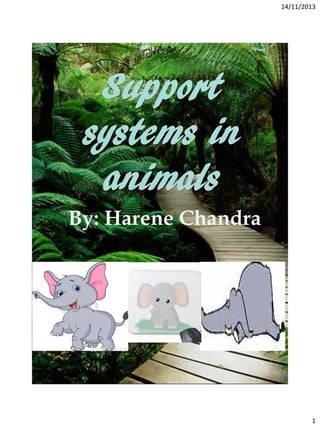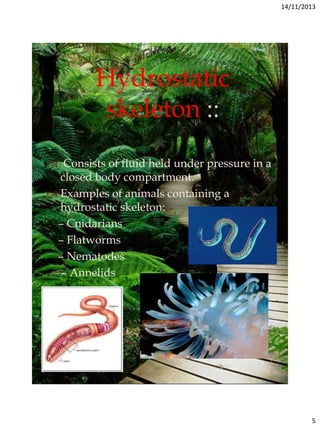Support systems in animals
- 2. 14/11/2013 Muscles :o ’éÖTo move, muscles must work in concert with a skeleton.ŌĆó The skeleton provides a rigid structure to which muscles are attached. ’éÖMuscles exert force only during contraction. Moving a body part back & forth requires two muscles attached to the same section of the skeleton. ’éÖThese two muscles are known as an antagonistic pair, which functions cooperatively. The nervous system coordinates these muscles. 2
- 3. 14/11/2013 The main function of a skeleton ’éÖSupport ’éÖProtection ’éÖMovement 3
- 4. 14/11/2013 Types of skeletons :: A hydrostatic skeleton An An Endoskeleton Exoskeleton 4
- 5. 14/11/2013 Hydrostatic skeleton :: ’éÖ Consists of fluid held under pressure in a closed body compartment. ’éÖ Examples of animals containing a hydrostatic skeleton: ŌĆō Cnidarians ŌĆō Flatworms ŌĆō Nematodes ŌĆō Annelids 5
- 6. 14/11/2013 Hydrostatic skeleton :: ’éÖ Movement and form is controlled by using muscles to change the shape of the fluid filled compartment ’éÖ A Hydra, for example, elongates by closing its mouth by using contractile cells in its body wall. This results in the constriction of its central gastro-vascular cavity. ’éÖ By decreasing the diameter of the cavity, the cavity is forced to become longer. 6
- 7. 14/11/2013 Body structure of a Hydra :? 7
- 8. 14/11/2013 Exoskeletons ’éÖ Hard, encasement deposited on an animalŌĆÖs surface; for example, most molluscs (slugs and snails) are enclosed in a calcium carbonate shell secreted by the mantle (sheet like extension of the body wall) ’éÖ As the animal grows, it enlarges its shell by adding to the outer edge. 8
- 9. 14/11/2013 Exoskeletons ’éÖ For example, crustaceans (like lobsters) harden portions of their exoskeleton by adding calcium salts. ’éÖ In leg joints, where the cuticle is thin and flexible, cross linking of proteins and inorganic salt decomposition occurs. ’éÖ With each growth spurt, an arthropod must shed its exoskeleton to produce a larger one, thus they molt. 9
- 11. 14/11/2013 Endoskeletons ’éÖ Consist of hard, supporting elements, such as bones which is buried within the soft tissue of animals. ’éÖ Sponges are reinforced by hard, needle like structures of inorganic materials, or by softer fibres made of protein. ’éÖ Echinoderms have an endoskeleton of hard plates called ossicles beneath their skin. ’éÖ Ossicles are composed of magnesium carbonate, calcium carbonate crystals and are usually bound together by protein fibres. 11
- 16. 14/11/2013 Comparison of the support system in land and aquatic vertebrates 16
- 17. 14/11/2013 Comparison of the support system in land and aquatic vertebrates 17
- 18. 14/11/2013 Comparison of the support system in land and aquatic intervertebrates 18



















